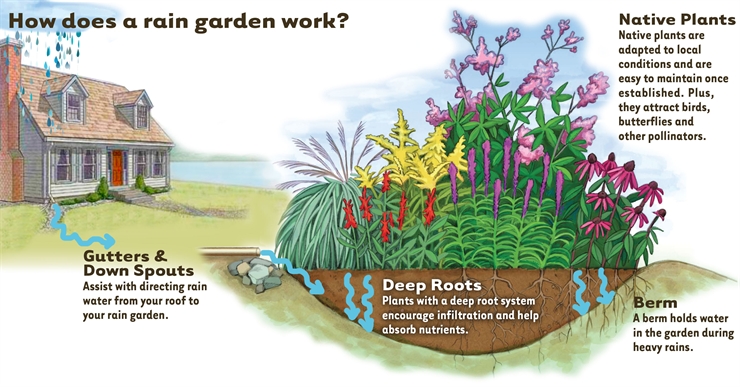|
A rain garden is a shallow, constructed depression to catch rainwater. It contains plants that tolerate standing water for several hours. If it is designed properly, all water from a rain event will soak into the ground within 48-72 hours. Rain gardens receive a rush of polluted stormwater from hard surfaces (such as sidewalks, driveways, roofs, and streets), hold the water for a short period of time, and allow it to naturally soak into the ground. The plants and soil remove most pollutants so that the rainwater can recharge the groundwater with clean healthy water.
|
Image Credit: Tip of the Mitt Watershed Council
|
WHAT ARE THE BENEFITS?
Rain gardens increase the amount of water that filters into the ground, removing pollutants and recharging groundwater. This helps protect lakes and rivers by intercepting urban stormwater that would have run off hard surfaces and picked up pollutants along the way. These pollutants include lawn fertilizers, leaves and grass, sediment, pesticides, oil and other automotive fluids, and bacteria from pet and wildlife waste. Rain gardens also enhance the beauty of yards and neighborhoods and provide valuable habitat for birds, butterflies and many beneficial insects.
RAIN GARDEN PLANTS
Rain gardens usually are filled with native plants. Native plants are evolved to fit their environment. They are naturally drought, flood and pest resistant in their native region. That translates to less work for the novice gardener and the pro, once all the initial work is done.
ADDITIONAL RESOURCES
Raingarden Guide for Southwest Ohio: An OSUE, Hamilton County, publication developed through funding support from the Metropolitan Sewer District of Greater Cincinnati. This manual is a practical handbook for home gardeners!
Rain Garden Manual: A wonderful resource pdf created for Ohioians by Geauga Soil and Water Conservation District and the Ohio Department of Natural Resources - Division of Wildlife.
Central Ohio Raingarden Initiative: The Central Ohio Rain Garden Initiative (CORGI) is a collaborative effort to promote the benefits of rain gardens for community beautification and clean water. This website is funded by a grant from the Ohio Environmental Protection Agency’s Ohio Environmental Education Fund.
Blue Thumb! Planting for Clean Water: This design and installation guide is a valuable raingarden reference guide for homeowners and professional designers. Thoroughly researched and beautifully illustrated, the book is approachable for beginners, yet contains detailed information for landscape professionals. It contains easy-to-follow instructions on designing, installing, planting and caring for raingardens, including example plans for different settings and information on more than 100 suitable plants from Zones 3, 4, and 5 in the Midwest.
STEPS TO CREATING A RAIN GARDEN
|
1. Assess your site
The Story of a Rain GardenBecome a Master Rain Gardener!
|


